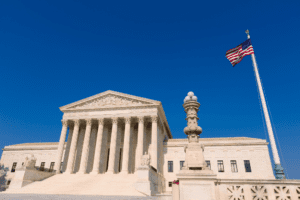 Second, the Court’s opinion today compounds these problems, for it gives the lower courts precious little guidance regarding how to resolve modern constitutional questions based almost solely on history. See, e.g., ante, at 1 (BARRETT, J., concurring) (“highlighting two methodological points that the Court does not resolve”). The Court declines to “provide an exhaustive survey of the features that render regulations relevantly similar under the Second Amendment.” Ante, at 20. Other than noting that its history-only analysis is “neither a . . . straightjacket nor a . . . blank check,” the Court offers little explanation of how stringently its test should be applied. Ante, at 21. Ironically, the only two “relevan[t]” metrics that the Court does identify are “how and why” a gun control regulation “burden[s the] right to armed self-defense.” Ante, at 20.
Second, the Court’s opinion today compounds these problems, for it gives the lower courts precious little guidance regarding how to resolve modern constitutional questions based almost solely on history. See, e.g., ante, at 1 (BARRETT, J., concurring) (“highlighting two methodological points that the Court does not resolve”). The Court declines to “provide an exhaustive survey of the features that render regulations relevantly similar under the Second Amendment.” Ante, at 20. Other than noting that its history-only analysis is “neither a . . . straightjacket nor a . . . blank check,” the Court offers little explanation of how stringently its test should be applied. Ante, at 21. Ironically, the only two “relevan[t]” metrics that the Court does identify are “how and why” a gun control regulation “burden[s the] right to armed self-defense.” Ante, at 20.
In other words, the Court believes that the most relevant metrics of comparison are a regulation’s means (how) and ends (why)—even as it rejects the utility of means-end scrutiny. What the Court offers instead is a laundry list of reasons to discount seemingly relevant historical evidence. The Court believes that some historical laws and decisions cannot justify upholding modern regulations because, it says, they were outliers. It explains that just two court decisions or three colonial laws are not enough to satisfy its test. Ante, at 37, 57. But the Court does not say how many cases or laws would suffice “to show a tradition of public-carry regulation.” Ante, at 37. Other laws are irrelevant, the Court claims, because they are too dissimilar from New York’s concealed-carry licensing regime. See, e.g., ante, at 48–49. But the Court does not say what “representative historical analogue,” short of a “twin” or a “dead ringer,” would suffice. See ante, at 21 (emphasis deleted).
A fair point in support of the dissent is that Justice Thomas’s majority opinion appears to be results-oriented. Justice Thomas has been the most predictable Justice on the Court as far as how he will ultimately rule on a case: in favor of the police and other traditionally “conservative” causes. On the other hand, the late Justice Scalia and Justice Stevens, for example, would offer the occasional surprising opinion despite their strong tendencies as members of the “conservative” and “liberal” wings of the Court.
